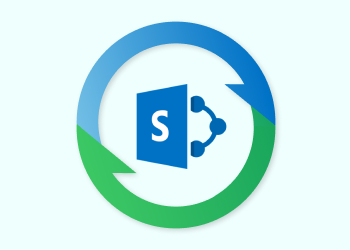Since Office 365 has a built-in collaboration portal - SharePoint Online - it is easy to start sharing the data across the company and its partners.
In this article, we are going to overview how to backup Office 365 SharePoint data.
How to Backup Office 365 SharePoint
Even if we assume that external disasters are less likely to strike a cloud data center, typical daily cases are still here: human errors when editing the document, inaccurate data cleaning, analysis of disputed situations, etc. These are hard to resolve without a data backup.
Microsoft Office 365 allows you to perform data recovery for SharePoint Online using a few approaches:
- Manually copying files and emails using Microsoft Outlook Client and OneDrive app synchronization.
- Using recycle bin and files version history tools. These allow you to recover most important things after accidental file deletion or incorrect data modification.
- By asking Microsoft staff to recover your entire SharePoint portal via a support request.
- Attach external cloud backup tool and perform data protection and recovery by your own means.
If we talk about granular “data corruption” of any kind, a third backup option is excluded. You will most likely not want to recover the entire SharePoint site to get back a few user files while losing hours of work performed in the time frame between files deletion and recovery.
Now let’s overview these backup ways in more details.
Manual Data Copying and Version History
If you are an experienced Windows user, you can remember the files version history feature, allowing you to restore one of the previous file’s states. SharePoint Online has a similar option for lists and libraries. If you just want to roll back unnecessary document changes or even to recover an accidentally deleted file - it is one of the best ways. But, of course, it is not equivalent to the “classical” backup of Office 365 SharePoint.
Just expand the desired list or library, and then open the context menu - Version History is right there.
Note: versioning is enabled by default only for libraries, so you should enable it for lists using the manual on this support page.
There is also a way to create a separate data copy for most of the SharePoint items using client apps, such as Microsoft Outlook or OneDrive app. You can find server-side data export dialogs on the Connect & Export ribbon. Remember that every piece of such a process needs to be done mostly manually, so it is quite a complex activity. But if you need to create a separate backup for free, or export the data to an external system, consider the following table of tools needed:
| What to backup | Necessary tool |
| Calendars, contacts, tasks, discussions | Microsoft Outlook |
| Document libraries | Microsoft Outlook / Windows File Explorer / OneDrive app |
| Lists content | Microsoft Office suite (Access, Excel) |
Microsoft Support Request
You can even restore SharePoint data with no additional backup efforts - just ask Microsoft to do this for you. Office 365 allows you to request a restore of all your SharePoint site collection by creating a support request.
Although it is the easiest recovery way, remember that you cannot select only a few files or mailboxes - Microsoft staff will restore the entire SharePoint content on a specified date. It means that you will lose any progress made since the backup was created by Microsoft. And you can’t track when exactly it was.
Consider the following specifics of request-driven restoration:
- You can not specify an exact backup time: Microsoft will ask to choose the earliest backup time, the desired time, and the oldest possible time - their support staff will extract the backup closest to your desired time.
- Microsoft creates a backup for your SharePoint Online every 12 hours. The data will be stored for 14 days.
- Restoration may take up to two days, starting with the support request creation. This is part of Office 365 SLA and you can not increase the priority even if a lot of client licenses are bought.
When asking for such a recovery type, make corrupted SharePoint instances read-only for users - it will help to avoid losing the work performed since the last backup was created by Microsoft.
Backup Using Third-Party Tools
If you are not satisfied with the version history possibilities (they are sometimes not equivalent to backups) and don’t want to recover an entire SharePoint server in case only a few files are lost - consider using third-party tools.
Specialized cloud tools for performing Office 365 SharePoint Online backup allow you to skip tedious manual operations, increase data protection automation, and save a lot of time on restoration. You will also get all-in-one data backup software that will help in case of any disaster or data corruption. If you still do not select the right tool for your particular case - try our MSP360 Backup for Microsoft Office 365, and get the following benefits:
- Perform Office 365 online backups using 256-bit AES encryption. You can also protect contacts, calendars, OneDrive files, and other data.
- Recover individual emails using item-level recovery.
- Maintain cloud storage space by using Retention Policies, allowing you to automatically purge unnecessary data.
One of the great things about cloud-ready backup tools is that you do not need to implement any physical servers or create virtual instances. Just register on our portal and connect your Office 365 organization.
Summary
Office 365 has a few useful ways to protect your data. If your company is relatively small and you do not have your own IT department - consider using SharePoint Version History to granularly recover data, and remember about support requests in case something goes completely wrong.
But if your infrastructure grows fast and you need to optimize a time-consuming backup process - try our MSP360 Backup for Microsoft Office 365 to perform Office 365 SharePoint online backup, and check whether it meets your business needs.




